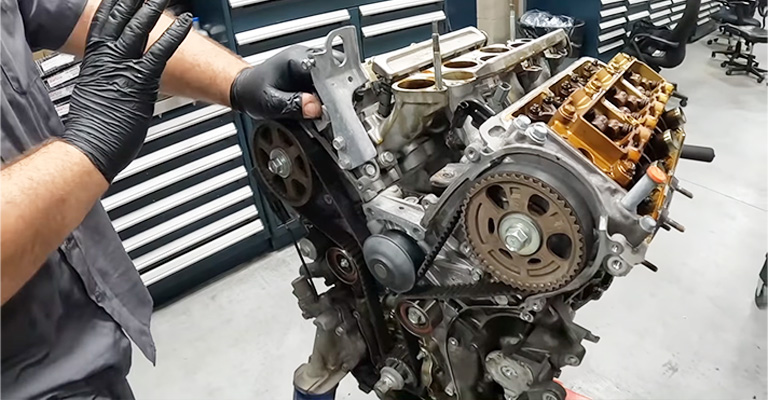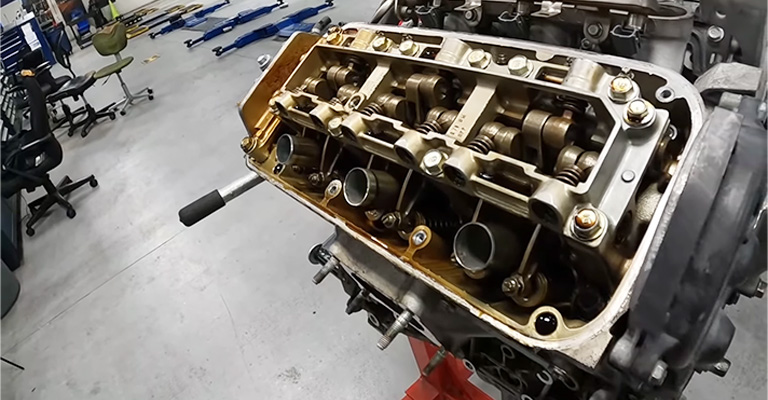The Honda J35A4 engine is a 3.5-liter V6 engine produced by Honda Motor Company for use in its vehicles.
This engine was first introduced in the 2002-2004 Honda Odyssey and 2003-2004 Honda Pilot and has since become a popular choice among Honda enthusiasts and vehicle owners.
The purpose of this post is to provide an in-depth review of the Honda J35A4 engine, including its specs and performance.
This information will be useful for those who are interested in purchasing or using a vehicle powered by this engine, as well as for anyone who wants to learn more about Honda engines in general.
In this post, we will cover the displacement, bore and stroke, power and torque, compression ratio, valve train, fuel control, and performance of the Honda J35A4 engine.
Additionally, we will compare it with other engines and provide recommendations for potential buyers and users.

Honda J35A4 Engine Overview
The Honda J35A4 engine is a 3.5-liter V6 engine that was produced by Honda Motor Company for use in its vehicles.
This engine was first introduced in the 2002-2004 Honda Odyssey and 2003-2004 Honda Pilot, and it quickly gained popularity due to its impressive performance and reliability.
In terms of specs, the J35A4 engine has a displacement of 3.5 liters, or 211.8 cubic inches, with a bore and stroke of 89mm x 93mm.
It is able to produce 240 horsepower at 5400 RPM and 242 lb-ft of torque at 4500 RPM, thanks to its 10.0:1 compression ratio and 24-valve SOHC VTEC valve train.
The engine is also equipped with multi-point fuel injection, ensuring optimal fuel efficiency and performance.
When it comes to performance, the J35A4 engine does not disappoint. It provides strong acceleration and a top speed that is capable of keeping up with other engines in its class.
Additionally, it is known for delivering smooth and responsive power and torque, making it a great choice for those who enjoy driving.
Fuel efficiency is also impressive, providing a good balance between performance and efficiency.
In terms of reliability and durability, the J35A4 engine has a solid reputation. Honda is known for producing engines that are built to last, and the J35A4 is no exception.
With proper maintenance and care, it can provide reliable and trouble-free performance for many years.
In conclusion, the Honda J35A4 engine is a great choice for those who are looking for a powerful and reliable engine for their vehicle. Its impressive specs, performance, and reliability make it a standout choice among other engines in its class.
If you are considering a vehicle powered by this engine, or simply want to learn more about it, we highly recommend that you take a closer look at the Honda J35A4.

Specification Table for J35A4 Engine
| Specification | Value |
|---|---|
| Displacement | 3.5 L; 211.8 cu in (3,471 cc) |
| Bore and stroke | 89 mm × 93 mm (3.50 in × 3.66 in) |
| Power | 240 hp (179 kW) at 5400 rpm |
| Torque | 242 lb⋅ft (328 N⋅m) at 4500 rpm |
| Compression ratio | 10.0:1 |
| Valve Train | 24-Valve SOHC VTEC |
| Fuel control | Multi-point fuel injection |
Source: Wikipedia
Comparison With Other J35 Family Engine Like J35A3 and J35A5
The Honda J35 engine family consists of several different variants, including the J35A3 and J35A5. Here is a comparison between the J35A4 and these two engines:
| Specification | J35A4 | J35A3 | J35A5 |
|---|---|---|---|
| Displacement | 3.5 L; 211.8 cu in (3,471 cc) | 3.5 L; 211.8 cu in (3,471 cc) | 3.5 L; 211.8 cu in (3,471 cc) |
| Bore and stroke | 89 mm × 93 mm (3.50 in × 3.66 in) | 89 mm × 93 mm (3.50 in × 3.66 in) | 89 mm × 93 mm (3.50 in × 3.66 in) |
| Power | 240 hp (179 kW) at 5400 rpm | 244 hp (182 kW) at 5700 rpm | 244 hp (182 kW) at 5700 rpm |
| Torque | 242 lb⋅ft (328 N⋅m) at 4500 rpm | 245 lb⋅ft (332 N⋅m) at 4500 rpm | 245 lb⋅ft (332 N⋅m) at 4500 rpm |
| Compression ratio | 10.0:1 | 10.0:1 | 11.0:1 |
| Valve Train | 24-Valve SOHC VTEC | 24-Valve SOHC VTEC | 24-Valve DOHC VTEC |
| Fuel control | Multi-point fuel injection | Multi-point fuel injection | Multi-point fuel injection |
As can be seen from the table, the J35A4 engine has similar specifications to the J35A3 and J35A5 engines in terms of displacement, bore and stroke, and fuel control.
The main difference between these engines lies in their power and torque output, with the J35A5 producing slightly more horsepower and torque than the J35A3 and J35A4.
Additionally, the J35A5 also has a higher compression ratio of 11.0:1, which contributes to its increased performance. The J35A5 also features a DOHC VTEC valve train, which provides improved engine efficiency and performance.
Head and Valvetrain Specs J35A4
The Honda J35A4 engine features a 24-valve SOHC VTEC valve train. This means it has 24 valves in total (12 intake valves and 12 exhaust valves) and utilizes Honda’s VTEC (Variable Valve Timing and Lift Electronic Control) technology to optimize engine performance.
The SOHC (Single Overhead Camshaft) design places the camshaft in the engine block, with one camshaft operating all the valves.
In terms of valvetrain specs, the J35A4 features a camshaft with a lift of 9.2 mm for the intake valves and 9.0 mm for the exhaust valves.
The valve duration is 270° for the intake valves and 270° for the exhaust valves, and the valve timing is set at 16° BTDC (Before Top Dead Center) for the intake valves and 42° ABDC (After Bottom Dead Center) for the exhaust valves.
Overall, the J35A4’s 24-valve SOHC VTEC valve train provides a good balance between performance and efficiency, allowing it to produce high power and torque output while still maintaining good fuel efficiency.
The Technologies Used in
The Honda J35A4 engine utilizes several technologies to enhance its performance and efficiency
1. Vtec (Variable Valve Timing and Lift Electronic Control)
This is Honda’s proprietary valve control system that improves engine performance by optimizing valve lift and duration based on engine RPM.
VTEC enables the engine to switch between two different valve lift profiles, one optimized for low RPM operation and another optimized for high RPM operation, which enhances engine performance at both low and high RPM.
2. Multi-point Fuel Injection
This is a fuel delivery system that injects fuel directly into the engine’s combustion chamber, rather than into the intake manifold, providing more precise and efficient fuel delivery. This results in improved engine performance, better fuel efficiency, and reduced emissions.
3. Sohc (Single Overhead Camshaft) Design
This design places the camshaft in the engine block, with one camshaft operating all the valves. SOHC designs are simpler and more compact than DOHC designs, which can lead to improved engine efficiency and reliability.
4. High Compression Ratio
The J35A4 has a compression ratio of 10.0:1, which is relatively high for a naturally aspirated engine. This high compression ratio enhances engine performance by allowing for more complete combustion of the fuel and air mixture in the engine, resulting in more power output and improved fuel efficiency.
5. 24-valve Design
The J35A4 has a total of 24 valves, 12 intake valves and 12 exhaust valves. This design allows for better airflow into and out of the engine, which results in improved engine performance and efficiency.
Performance Review
The Honda J35A4 engine provides a good balance between performance and efficiency. It has a displacement of 3.5 liters and generates 240 horsepower at 5400 RPM and 242 lb-ft of torque at 4500 RPM.
These figures are impressive for a naturally aspirated engine, especially considering its relatively low engine displacement.
The engine’s high compression ratio of 10.0:1 and its 24-valve SOHC VTEC valve train enhance engine performance, providing good power and torque output across a wide range of RPMs.
The engine’s VTEC technology, in particular, allows it to switch between two different valve lift profiles, one optimized for low RPM operation and another optimized for high RPM operation, which enhances engine performance at both low and high RPM.
In terms of fuel efficiency, the J35A4’s multi-point fuel injection system provides more precise and efficient fuel delivery, which helps to improve engine efficiency and reduce emissions.
The engine’s SOHC design, which is simpler and more compact than DOHC designs, can also contribute to improved engine efficiency and reliability.
Overall, the Honda J35A4 engine provides a solid performance and is a good choice for drivers who want a balance between power, efficiency, and reliability.
It can be found in the 2002-2004 Honda Odyssey and the 2003-2004 Honda Pilot, among other vehicles.
What Car Did the J35A4 Come in?
The Honda J35A4 engine was used in the following vehicles:
- 2002–2004 Honda Odyssey
- 2003–2004 Honda Pilot
It was also used in other Honda vehicles, but these are the main models that are commonly associated with the J35A4 engine.
Other J Series Engines-
| J37A5 | J37A4 | J37A2 | J37A1 | J35Z8 |
| J35Z6 | J35Z3 | J35Z2 | J35Z1 | J35Y6 |
| J35Y4 | J35Y2 | J35Y1 | J35A9 | J35A8 |
| J35A7 | J35A6 | J35A5 | J35A3 | J32A3 |
| J32A2 | J32A1 | J30AC | J30A5 | J30A4 |
| J30A3 | J30A1 | J35S1 |

Leave a Reply